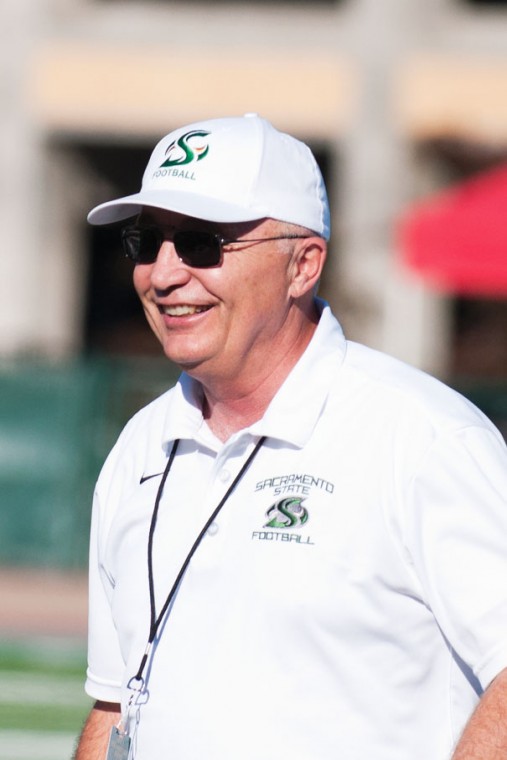Director seeks changes in the sports budget
terry wanless:Athletic director Terry Wanless overlooks Sac State?s sports budget.:Steven Turner – State Hornet
December 1, 2010
The Sacramento State athletic budget has affected all programs that rely on the money for recruiting, staff salary and operational costs. However, it is the staff salary – more specifically, assistant coaches salaries, that is most talked about.
Sac State Athletic Director Terry Wanless said the three main areas in which he wants to see budget improvements are in hiring additional strength coaches, additional athletic trainers and improving our assistant coaches’ salaries.
“I’m pretty comfortable with our head coaches salaries, but we need to improve assistant coaches salaries,” Wanless said. “They are not even being paid at the level as an assistant instructor on campus and I think there should be some comparability between those two.”
Cara Hoyt, Sac State’s softball associate head coach, is entering her sixth season with the Hornets and said she remains at the same pay grade as the day she was hired.
“I put in as much time as any other coach on the softball staff,” Hoyt said. “I love the area and I really enjoy working with the softball program and so I am not actively job hunting. Other institutions have approached me, but it would be a tough decision to leave. I am hopeful that our salaries can be increased. That would make it easier to stay.”
Hoyt is not the only one that feels this way. Both the men’s and women’s cross country teams have had their greatest success over the past four years despite having their budget reduced.
“I have two terrific assistant coaches who do a top-notch job for relatively little pay,” said Kathleen Raske, director of track and field/cross country. “I am lucky I haven’t lost them to other institutions because they are highly marketable. They stay because they are proud of our program, love the area and are loyal. You can’t put a price on that, but any increase in pay would be nice.”
One of the coaches who Raske is speaking of is Jeff Magley, who is entering his sixth season with the track and cross country teams.
“The salaries can make it tough, especially living in California and trying to support a family of five,” Magley said. “I have been here five years now and there has been no change to my personal salary. That’s a fair amount of time without even a cost of living adjustment. Believe me there isn’t a single assistant here that does it for the money, we’re doing it because we love the sport and the kids we get a chance to work with.”
As most people know, the CSU funding system has been hit very hard in recent years and all Sac State departments have suffered because of it. Besides a lack of state funding, there is another variable that must be looked at when discussing the school’s athletic budget.
Sac State’s athletic budget supports more teams than any other school in the Big Sky Conference, which forces the school to divide the $10.2 million budget among 20 teams. Most other conference members have between 14 and 16 teams.
“We are probably in the top three in the conference for total athletic budget amount,” Wanless said. “But it is misleading because of us having 20 sports. You can’t just look at the dollar amount as a way to compare.”
On the flip side, Wanless pointed out some advantages that our athletic teams have over other conference members. Having highly populated cities in the surrounding areas allow Sac State to recruit closer to home. A team from the University of Montana must fly their coaches in order to visit recruits, costing them far more money.
Wanless said the athletic budget is close to where it needs to be but he is always looking for ways to bring in more money for his teams.
“We are what you call an education model which is a pretty consistent model throughout the FCS,” Wanless said. “The main areas we can improve upon are ticket sales and corporate sponsorship, which can only be achieved by winning.”
Wanless describes the barriers his basketball teams face in trying to increase ticket sales.
“We are at a disadvantage here because we have a small arena,” Wanless said. “So it’s hard to improve upon ticket sales for basketball games when your arena capacity is a relatively low number.”
There is no doubt that Sac State’s athletic budget has been depleted in recent years, creating additional challenges to the school’s coaching staffs. However, Wanless remains positive that his teams will continue improving and contend for conference championships.
“We are very comfortable with who we are,” Wanless said. “We are proud of the fact that we have 20 sports teams and are meeting a need to our student athletes by providing them with a variety of athletic programs. I think we truly represent what our region wants and expects from us.”
Brad Schmidt can be reached at bschmidt@statehornet.com
































































































































